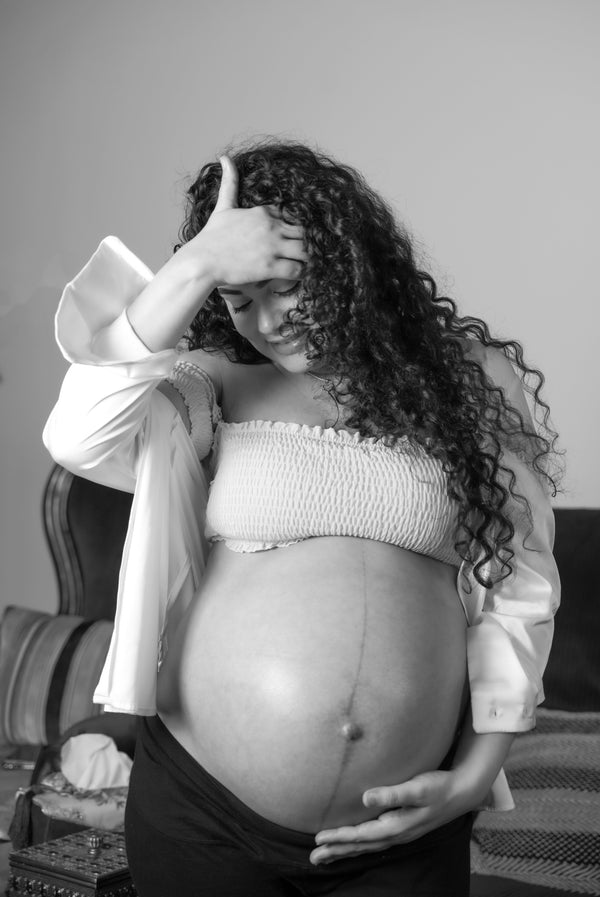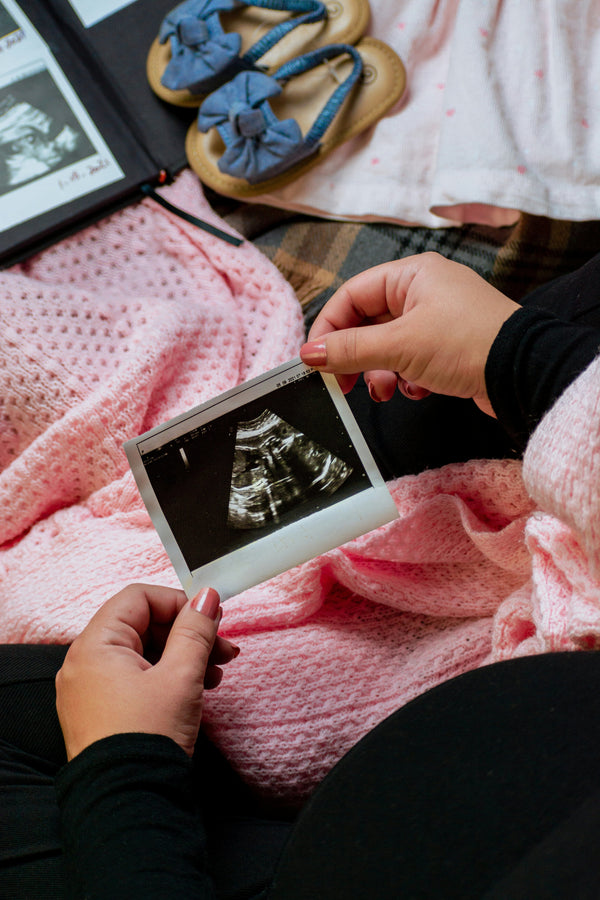Article
Mind, Body, Baby - Second Trimester
Posted on
Mind
By now you are probably in the swing of being pregnant and you may be in the ‘honeymoon’ period, with lots more energy and a renewed sense of well-being. Now is the time to start communicating with your baby on a much deeper level.
Screening tests should be out of the way and you will probably be feeling much more confident about the health of your baby. Ultrasound scans will have given you those first precious glimpses of what he or she looks like, but whatever image you have in your mind, you can now use it to deepen your emotional bond. Introduce your baby to some of your favourite music, sing and talk to her or him, tell them how much you are looking forward to holding them, what the rest of their family is like, how much you long for them – the point is that you are making a connection on a very deep, personal level. Choose a quiet time and find privacy, where no one can overhear you – then spend some quality time with your baby.
Bonding visualisation
Try this visualisation technique:
- Make yourself comfortable – perhaps by lying down on your bed or a couch
- Place your hands in a heart-shaped position with your thumbs to your tummy button and your fingers pointing to your pubic bone. This helps you make a connection with your baby
- Close your eyes and begin to breathe slowly. Let thoughts drift in and out of your mind
- Imagine a stream of light passing down through the top of your head to your forehead and down through your cheekbones. Feel yourself relaxing as the light reaches your jawbone
- Release any tension, allowing your lips to part a little and your tongue to relax in your mouth. Send the light down through your neck and shoulders; feel your muscles relax one by one, as it continues down through your arms and hands
- Now imagine the light flowing down through an imaginary line in the centre of your body. This is an acupuncture meridian called the Conception Vessel
- Just imagine, for a minute or so, that place between your breasts, where you have that connection with the heart, where you feel love, warmth and deep relaxation. The hormones you produce when you are content are the ‘love hormones’, including oxytocin, which is sent through your body after the birth to help you bond with your baby
- Allow the light to travel down into your uterus and picture your baby’s little body. His or her fingers and toes may be curled up or wriggling. She or he is snug, safe and secure, responding to your calm, relaxed state with your heartbeat slowly beating as a backdrop to theirs. She or he is thriving and growing at an amazing rate
- Visualise the umbilical cord allowing all the nourishment that you are taking in to pass through to your baby. You are also sending all those wonderful ‘happy hormones’ and the amazing love, warmth and emotion that you feel for them
- Think of how your baby is connecting with you, that she or he is conscious and becoming aware of your love
- Stay with this for a while and then allow the stream of light to pass on down to your knees and lower legs, feeling calm and relaxed
Body

Your pregnancy is now becoming quite noticeable and you will probably feel a surge of renewed energy, good health and a relaxed sense of well-being. In the next three months your baby will go through several rapid growth spurts and to ensure a steady supply of nutrients you need to maintain your balanced diet. However, you also need to focus on calcium, magnesium, phosphorus, manganese and Vitamin D for strong bones. The crucial importance of Vitamin D in bone formulation has been overlooked in the past, and many women are deficient. The problem is especially pronounced in darker-skinned women because vitamin D is absorbed from sunlight and stored under the surface of the skin, so while darker skin is better protected from UV rays, it also means it requires greater amounts of sunshine to be able to absorb enough vitamin D. While this essential vitamin is found in some foods, exposure to sun is the best way to get your quota, which can be hard in the UK! Make sure you take a supplement to keep you topped up.
Exercise and posture
During this second trimester, you will undergo some dramatic physical changes and your bump will be larger and heavier. Stretching and strengthening exercises will help your body to cope.
As your baby grows, your pelvis tends to tilt forwards, creating a deeper curve in your lower back. This can lead to back pain and other related aches and pains in your neck, shoulders, hips and even arms. One of the best ways to counteract this is to pull your tummy button in towards your spine at all times. This activates a band of muscle around your abdomen called your transverse abdomens, which helps support your growing bump and takes the pressure off your back. The pull of your growing bump can lead to the tightening of certain muscle groups, while others are being stretched and weaken. Your aim in any exercise is to gently work the stretched, weekend muscles using light weights, resistance bands or your own body weight to gradually stretch muscles that have a tendency to tighten.
During this second trimester, you will undergo some dramatic physical changes and your bump will be larger and heavier. Stretching and strengthening exercises will help your body to cope.
Perfect Posture
As your baby grows, your pelvis tends to tilt forwards, creating a deeper curve in your lower back. This can lead to back pain and other related aches and pains in your neck, shoulders, hips and even arms. One of the best ways to counteract this is to pull your tummy buttons in towards your spine at all times. This activates a band of muscle around your abdomen called your transverse abdomens, which helps support your growing bump and takes the pressure off your back. The pull of your growing bump can lead to the tightening of certain muscle groups, while others are being stretched and weakened. Your aim in any exercise is to gently work the stretched, weekend muscles using light weights, resistance bands or your own body weight to gradually stretch muscles that have a tendency to tighten.
Baby
In these next few months all your baby’s organs, systems and structures that were laid down in the first trimester will grow and develop at an astonishing rate. She or he will be making their presence known too, at first with tiny, fluttering movements, but soon with more definite and recognisable kicks.
Week 14
This week sees your baby ‘practising’ breathing. Her or his growth rate increases and the nervous system has begun to function. She or he also has nails.
Week 15
Hearing mechanisms are developing. In just a few more weeks she or he will be able to hear your heartbeat and voice. Lanugo is beginning to form a covering over your baby’s paper-thin skin and she or he is growing eyebrows.
Week 16
Ultrasound scans can now detect your baby’s sex. Her or his bones continue to harden and the joints are working. Her or his nervous system is functioning.
Week 17
Your baby is beginning to lay down fat, giving her or him energy to roll over and wave or kick. He or she can hear sounds and sudden noises may make them jump.
Week 18
The baby is entering her or his most active phase and is trying out movements. Her or his eyes are now in the correct position; there are touchpads on the fingers and fingerprints are forming.
Week 19
The placenta is still taking away waste products, but the kidneys are beginning to function.
Week 20
An important stage for sense development. The nerve cells linking sight, hearing, touch and smell are developing. Complex connections are being made that will be needed for memory and thinking.
Week 21
Your baby can respond to touch and tastebuds have developed. They may stroke their face and suck their thumb – they have enough room to make large movements.
Week 22
The skin is becoming less transparent and the brain is still developing at a phenomenal pace – producing brain cells now.
Week 23
Talk to your baby as much as you can – when she or he is born they’ll be able to recognise their parents’ voices.
Week 24
Your baby is practising her or his breathing by taking in amniotic fluid and the lungs are beginning to produce surfactant, a substance that prevents the air sacs within them sticking together.
Week 25
White blood cells are now being produced that are vital for fighting infection. Brown fat under the skin will help her or him regulate temperature after birth, and adult teeth are developing in buds.
Week 26
Your baby reacts to sounds now and studies have shown that unborn babies’ pulses will quicken in response to certain sounds.
Week 27
Your baby is getting much rounder and plumper. The eyelids have grown eyelashes and the retinas are forming; your baby will be able to sense change in light.
“At 16 weeks the foetus is about the size of your palm, but at 24 weeks your baby is about the same length as your elbow to wrist!”
Further reading
-

Is this normal in trimester 2?
Pregnancy can feel like a constant swirl of questions and new experiences. The second trimester is often called the “honeymoon... -

Myths About Early Pregnancy Safety
Trigger Warning: This post discusses early pregnancy, including topics such as miscarriage and common symptoms. The first twelve weeks of...


